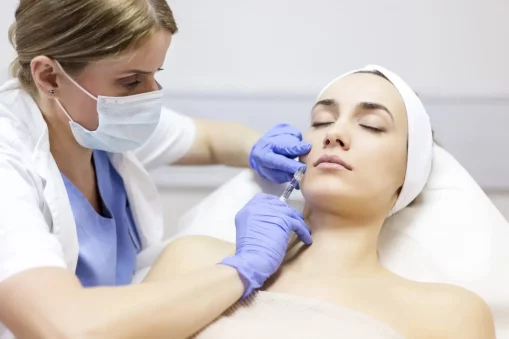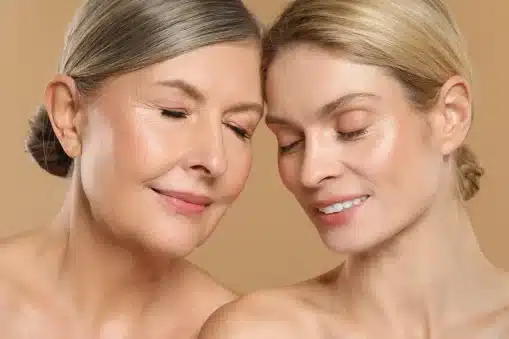As we age, our skin undergoes profound changes that affect its structure, elasticity, and overall health. These changes aren’t just about wrinkles; they involve deeper, biological processes that alter the skin’s ability to regenerate and maintain its youthful appearance. By the mid-20s, collagen production (the protein that keeps skin firm and supple) starts to decline by about 1% annually.
Similarly, elastin, the protein responsible for elasticity, diminishes, leaving the skin less resilient to movement and environmental stressors. The gradual loss of subcutaneous fat, which once provided a smooth and youthful contour, leads to sagging and more pronounced wrinkles. To add to this, the thinning of the skin’s outer layers and reduced hydration exacerbate these visible signs of aging. These cumulative changes significantly influence how aging skin responds to cosmetic interventions, making treatments like Botox and fillers adapt to meet the needs of mature skin.
Botox: Mechanism and Age-Related Considerations
Botox has long been a go-to solution for reducing the appearance of facial wrinkles, including under eyes, but its effectiveness can vary significantly depending on the age and condition of the skin. While it’s renowned for softening dynamic wrinkles, the impact of aging introduces new challenges and nuances that practitioners must address.
How Botox Works?
Botox, scientifically known as botulinum toxin type A, is a purified neurotoxin that temporarily blocks nerve signals to targeted muscles. This process prevents muscle contractions that cause dynamic wrinkles, which are lines that form from repetitive facial movements like frowning, smiling, or squinting. When injected strategically, Botox relaxes these muscles, smoothing the skin above and creating a refreshed appearance. The effects typically last three to six months, depending on individual factors such as metabolism, muscle activity, and injection technique.
Impact of Aging on Botox Efficacy
The natural aging process directly influences how well Botox works. In younger skin, Botox effectively minimizes dynamic wrinkles because the underlying muscles remain toned, and the skin retains enough elasticity to rebound after injections. However, with age, the skin loses collagen, elastin, and hydration, leading to static wrinkles—lines that remain visible even when the face is at rest. Static wrinkles, caused by years of repetitive movements combined with structural skin changes, are less responsive to Botox alone.
For mature skin, Botox often needs to be combined with complementary treatments to achieve optimal results. Research published in The Journal of Dermatologic Surgery suggests that pairing Botox with microneedling, chemical peels, or laser therapy can improve skin texture and enhance overall outcomes. These modalities address surface-level concerns like pigmentation and fine.
Customizing Botox for Aging Skin
As muscles weaken over time, Botox treatments in older adults require precise adjustments to dosage and injection techniques. An experienced practitioner might use microdosing — small, localized amounts of Botox — to maintain muscle function while softening wrinkles. This approach avoids over-paralysis, which can result in an unnatural or “frozen” appearance, a common concern for mature clients. Also, as a study published in Journal of Cutaneous and Aesthetic Surgery suggest, dosage is very important.
Additionally, the choice of injection sites evolves with age. For example, the forehead and glabellar (frown line) areas often require fewer units to avoid brow heaviness, a potential side effect in skin with reduced elasticity. Strategic placement ensures that the face maintains a balanced, natural appearance while achieving noticeable rejuvenation.
Dermal Fillers: Mechanism and Age-Related Considerations
Dermal fillers have revolutionized facial rejuvenation by addressing the volume loss and static wrinkles that Botox alone cannot treat. As we age, the natural contours of the face change dramatically due to the depletion of fat, collagen, and bone support. Understanding the science behind dermal fillers and their application in aging skin is crucial for achieving balanced and natural results. From selecting the right filler type to employing advanced techniques, practitioners play a pivotal role in customizing treatments for mature clients.
How Fillers Work?
Dermal fillers are injectable substances designed to restore facial volume, smooth static wrinkles, and enhance contours. Most fillers are composed of hyaluronic acid (HA), a naturally occurring substance in the body that attracts and retains moisture. When injected, HA-based fillers provide an immediate plumping effect, making them ideal for addressing volume loss and fine lines.
In addition to HA fillers, other types of fillers cater to specific aging concerns. Calcium hydroxylapatite (Radiesse) not only adds volume but also stimulates collagen production, resulting in longer-lasting improvements. Similarly, poly-L-lactic acid (Sculptra) works by encouraging the skin to rebuild its own collagen, offering gradual and more natural-looking enhancements over time.
Impact of Aging on Filler Efficacy
Aging significantly impacts how dermal fillers perform. As we age, areas such as the cheeks, temples, and jawline experience noticeable volume depletion. This structural loss makes fillers particularly effective in restoring youthful contours and reducing deep static wrinkles, like those around the nasolabial folds or marionette lines. One study also proved the importance of considering the difference between semi-permanent and permanent fillers as we age.
However, not all fillers are created equal, and their efficacy depends on skin thickness, elasticity, and the depth of the treatment area. For instance, dense fillers with a higher viscosity are better suited for addressing significant volume loss in deeper layers, mostly in the cheeks or jawline. Softer fillers with lower viscosity are ideal for delicate areas, like the under-eye region or fine lines around the lips.
Advanced Techniques for Aging Skin
The ability of aging skin to integrate fillers seamlessly is often diminished due to thinning skin and reduced collagen reserves. To counter this, advanced injection techniques are crucial. One such method is the use of microcannulas—blunt-tipped tools that minimize trauma, reduce bruising, and allow for precise filler placement in fragile skin. Cannulas are especially beneficial for areas like the tear troughs or nasolabial folds, where traditional needles may cause more swelling or damage.
Another effective strategy is layering different types of fillers to address multiple concerns simultaneously. For example, a denser filler might be used for structural support in the mid-face, while a softer filler smooths superficial lines. This multi-faceted approach ensures a natural and harmonious result.
Maximizing Results with Complementary Treatments
Fillers are highly effective on their own, but combining them with other treatments can enhance outcomes. For instance, combining dermal fillers with biostimulatory treatments like platelet-rich plasma (PRP) therapy can further boost collagen production. Similarly, skin resurfacing techniques, such as laser or microneedling, improve skin texture and elasticity, creating a smoother canvas for fillers to work on.
Potential Risks and Side Effects in Aging Skin
Botox and dermal fillers are widely considered safe and effective, yet aging skin introduces unique challenges that practitioners must address to ensure successful outcomes. Thinner, more delicate skin in older adults is more prone to bruising, swelling, and other minor side effects at injection sites. Also, reduced elasticity and structural changes in aging skin may increase the risk of complications if treatments are not administered with precision. Don’t forget about the effect of repeated treatments.
Common Risks in Aging Skin
In older adults, the thinning of the epidermis and reduced subcutaneous fat make the skin more susceptible to bruising and swelling post-injection. These side effects are typically temporary but can be more pronounced in individuals with fragile capillaries or those taking blood-thinning medications. Ice packs and gentle post-treatment care can help minimize these issues, but practitioners often adjust their techniques to reduce trauma in such cases.
Advanced Techniques to Mitigate Risks
Improper injection techniques can lead to complications like asymmetry, overcorrection, or a “frozen” appearance, particularly in aging skin with reduced elasticity. Skilled practitioners often use microcannulas—blunt-tipped tools designed to minimize tissue trauma and improve precision—especially in high-risk areas such as the tear troughs or nasolabial folds.
Another critical consideration is the risk of vascular occlusion, a rare but serious complication that occurs when filler inadvertently enters a blood vessel, leading to tissue damage or, in extreme cases, blindness. Aging skin, with its altered vascular anatomy, may increase the difficulty of avoiding these structures. To mitigate this risk, many practitioners are turning to advanced imaging tools, such as ultrasound, to visualize vascular structures in real time during injections. This technique significantly enhances safety, particularly in areas with complex vascular networks.
Conclusion
As we age, the skin’s evolving characteristics require a more thoughtful and nuanced approach to cosmetic treatments. Aging impacts not only the appearance of wrinkles and volume but also the skin’s overall texture, elasticity, and ability to respond to interventions like Botox and dermal fillers. This complexity underscores the importance of personalized treatment plans that respect the unique aging patterns of each individual, combining science, artistry, and expertise.
The advancements in modern aesthetic medicine provide a wide array of options to rejuvenate aging skin while maintaining a natural and balanced appearance. Through a blend of innovative techniques and a deep understanding of facial anatomy, practitioners can achieve results that enhance both confidence and comfort. Combining treatments such as injectables, skin-tightening therapies, and collagen-boosting procedures offers a comprehensive way to address multiple signs of aging, ensuring long-term satisfaction.
Ultimately, the goal of aesthetic treatments is not just to minimize the signs of aging but to celebrate individuality and preserve the essence of each person’s natural beauty. With the right strategy, aging gracefully becomes more than an aspiration—it becomes a reality supported by the expertise and dedication of skilled professionals. By prioritizing customization and safety, these interventions empower individuals to look and feel their best at every stage of life.
Frequently Asked Questions (FAQs)
Does the rate of collagen loss influence Botox and filler outcomes?
Yes, accelerated collagen loss in aging skin reduces the skin’s ability to bounce back, affecting both the smoothness achieved with Botox and the volume restoration with fillers.
Can lifestyle factors like smoking and sun exposure affect aging skin’s reaction to injectables?
Absolutely, smoking and excessive sun exposure exacerbate skin aging, leading to reduced elasticity and slower healing. These factors can diminish the effectiveness of both Botox and fillers and increase the likelihood of side effects.
Does aging make Botox take longer to show results?
Not typically, as Botox generally works within the same timeframe regardless of age. However, deeper wrinkles and less elastic skin might initially make the effects appear less dramatic, even if the muscle relaxation occurs as expected.
Is there a difference in post-treatment swelling between younger and older patients?
Older patients may experience slightly more visible swelling due to slower skin recovery and reduced circulation. It’s manageable, but careful aftercare is a must to minimize swelling and enhance results.
How does bone structure change with age influence filler application?
Age-related bone loss can create hollowness or sagging, particularly in the cheeks and jawline. Filler placement must account for these structural changes to restore balance and provide a rejuvenated appearance.
How can skin care routines enhance the effectiveness of Botox and fillers for mature skin?
A consistent skincare routine with ingredients like retinol, antioxidants, and hyaluronic acid can improve skin texture and hydration, helping Botox and fillers work more effectively and last longer. Proper sun protection is equally crucial for maintaining results.
References
Bravo BSF, Carvalho RM, Gallo BF, Bravo LG. A Retrospective Study Supporting the Importance of Individualizing the Dose of Botulinum Toxin According to the Age. J Cutan Aesthet Surg. 2021 Jan-Mar;14(1):88-92. doi: 10.4103/JCAS.JCAS_20_20. PMID: 34084014; PMCID: PMC8149977.
Sturm LP, Cooter RD, Mutimer KL, Graham JC, Maddern GJ. A systematic review of dermal fillers for age-related lines and wrinkles. ANZ J Surg. 2011 Jan;81(1-2):9-17. doi: 10.1111/j.1445-2197.2010.05351.x. PMID: 21299793.
Gold MH. Use of hyaluronic acid fillers for the treatment of the aging face. Clin Interv Aging. 2007;2(3):369-76. doi: 10.2147/cia.s1244. PMID: 18044187; PMCID: PMC2685277.



0 Comments